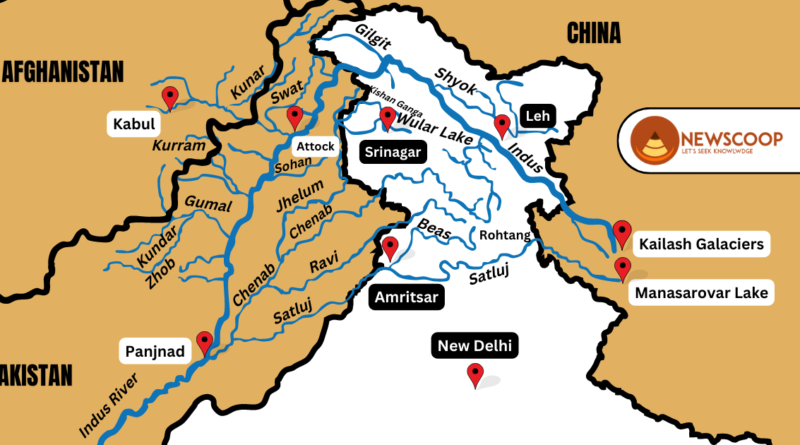Beas River: Map & Origin | Tributaries
If you are searching for information on the Beas River, then you are at the right place! In this article, you will get to know all about the Beas River, exploring its geographical features, historical significance, economic importance, and environmental challenges. From its origin in the mighty Himalayas to its journey through the heartlands of Himachal Pradesh and Punjab, we will unravel the captivating tale of this iconic river.
So, let’s embark on a fascinating expedition to uncover the many facets of the Beas River and understand its vital role in shaping the cultural and natural landscapes of northern India.
Geographical Features of Beas River
The following are the Geographical Features of the Beas River:
- Origin: The Beas River originates from the Beas Kund, a glacial lake situated at an elevation of over 4,000 meters in the Kullu district of Himachal Pradesh, India.
- Course: It flows through two Indian states, namely Himachal Pradesh and Punjab. The river travels approximately 470 kilometers from its source to its confluence with the Sutlej River in Punjab.
- Landscape: As it courses through the Himalayas and the surrounding valleys, the River carves through breathtaking landscapes, including deep gorges, lush green forests, and picturesque meadows.
- River Confluences: On its journey, the Beas River meets various other rivers and streams, creating confluences that further add to the river’s grandeur. One notable confluence is with the Parbati River, forming the famous Bhuntar-Kullu Gorge.
- Urban Centers: The River passes through or near several towns and cities, including Manali, Kullu, and Mandi in Himachal Pradesh, and Amritsar in Punjab. These urban centers rely on the river for various purposes, such as irrigation, drinking water, and tourism.
- Entirely in India: Beas River lies entirely in India.
- Join Satluj: The Beas River merges with the Sutlej River at Harike Pattan in Punjab, India, before continuing its course into Pakistan. After that Satluj joins the Indus River in Mithankot, Pakistan.
Tributaries of Beas River
The following are the tributaries of the beas river:
- Parbati
- Bain
- Banganga
- Luni and Uhal
- Chakki
- Gaj
- Patlikuhlal
- Sainj
- Suketi
- Tirthan
Important Dams on Beas River
The Beas River in India is dotted with several dams, which play a crucial role in water management, hydroelectric power generation, and irrigation. Some of the prominent dams include:
- Pong Dam (Maharana Pratap Sagar): Located in the state of Himachal Pradesh, the Pong Dam, also known as Maharana Pratap Sagar, is one of the largest man-made lakes in India. It was completed in 1974 as part of the Beas Project and serves as a significant reservoir for irrigation and drinking water supply in the surrounding regions. Additionally, it has a hydroelectric power generation capacity of 360 MW.
- Pandoh Dam: Situated on the Beas River in Himachal Pradesh, the Pandoh Dam was completed in 1977 during the initial phase of the Beas Project. It serves as a diversion dam and plays a vital role in diverting water to the Sutlej River through a tunnel to generate hydroelectric power.
- Larji Hydroelectric Project: Located near the town of Larji in Himachal Pradesh, the Larji Hydroelectric Project utilizes the waters of the Beas River for power generation. It has an installed capacity of around 126 MW.
Historical Significance
The Beas River holds a significant place in India’s history, particularly in connection with Alexander the Great’s conquests in 326 BC. During Alexander’s invasion of India, the Beas River marked the eastern-most border of his empire. The river posed a formidable challenge for Alexander’s forces, and it is said to have been a major obstacle in his campaign.
The name “Beas” has its origins in the Sanskrit name “Vipasha.” Some historical records link the river’s name to the sage Vyasa, known as Veda Vyasa, indicating that the river might have originated from the Vyasa Kund, a glacial lake.
In the 20th century, the Beas River underwent significant development with the implementation of the Beas Project. The project aimed at harnessing the river’s potential for irrigation and hydroelectric power generation. As part of the project, the Pong Dam was completed in 1974 during its second phase, followed by the Pandoh Dam in 1977, located around 140 kilometers upstream.
Initially built for irrigation purposes, the Pong Dam later began generating electricity, boasting a capacity of 360 MW. These dams have played a crucial role in enhancing agricultural productivity and meeting India’s growing energy needs.
Overall, the historical significance of the Beas River, its ancient name, and its modern-day development through the Beas Project all contribute to its enduring importance in India’s past and present
Conclusion
In conclusion, the Beas River is a vital lifeline flowing through the picturesque landscapes of Himachal Pradesh and Punjab. With its origins in the Himalayas and numerous tributaries, it supports agriculture, hydroelectric power generation, and tourism. While its geographical features contribute to the region’s prosperity, efforts must be made to address environmental challenges and ensure its sustainable preservation for future generations.
Thank You!
FAQs
Where does the Beas River originate?
The Beas River originates from the Beas Kund, a glacial lake situated at an elevation of over 4,000 meters (13,000 feet) in the Kullu district of Himachal Pradesh, India.
What is the total length of the Beas River?
The total length of the Beas River is approximately 470 kilometers (292 miles). It originates from the Beas Kund, a glacial lake in the Kullu district of Himachal Pradesh, India, and flows through the states of Himachal Pradesh and Punjab before eventually merging with the Sutlej River in Punjab, India.

